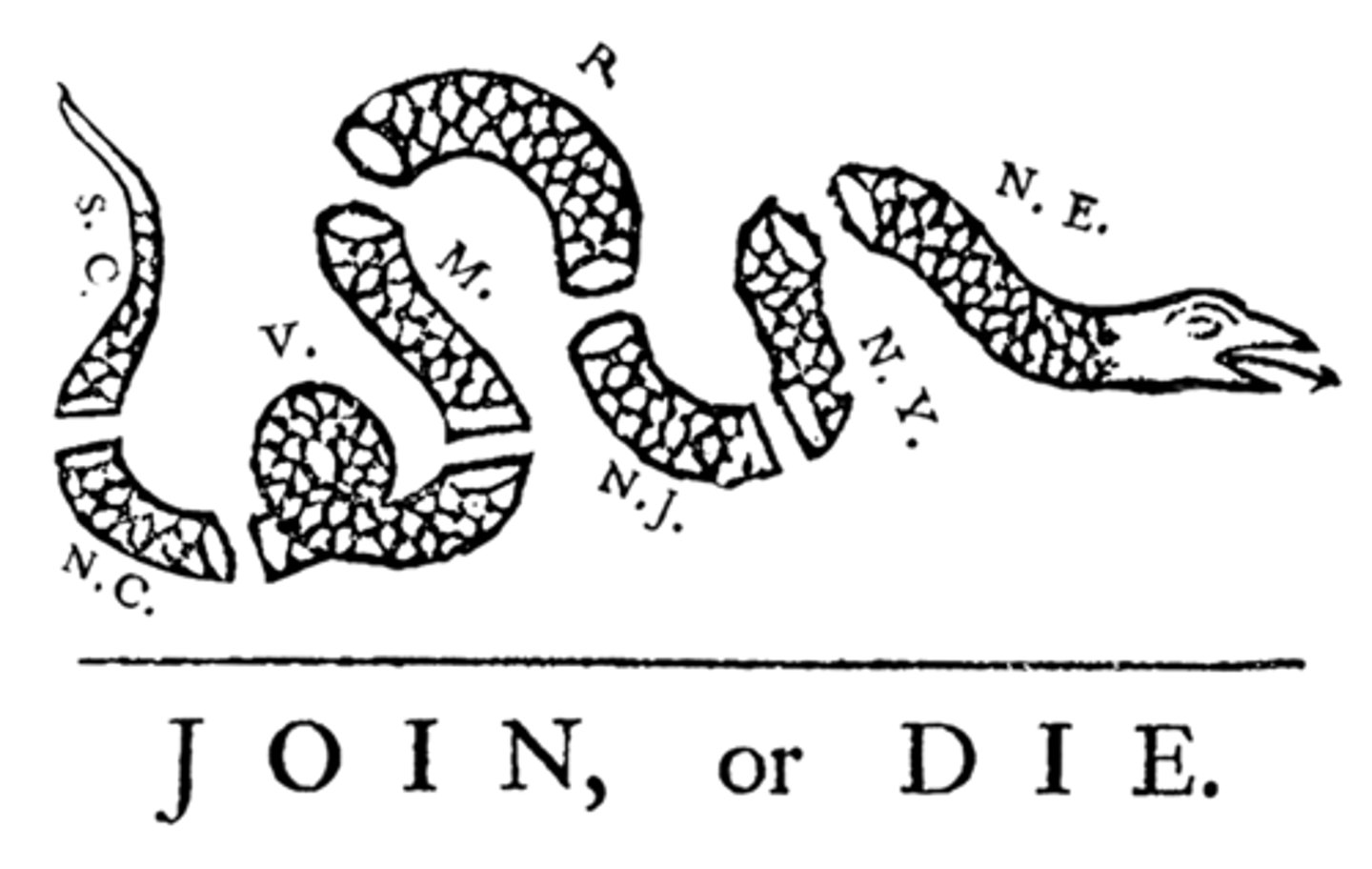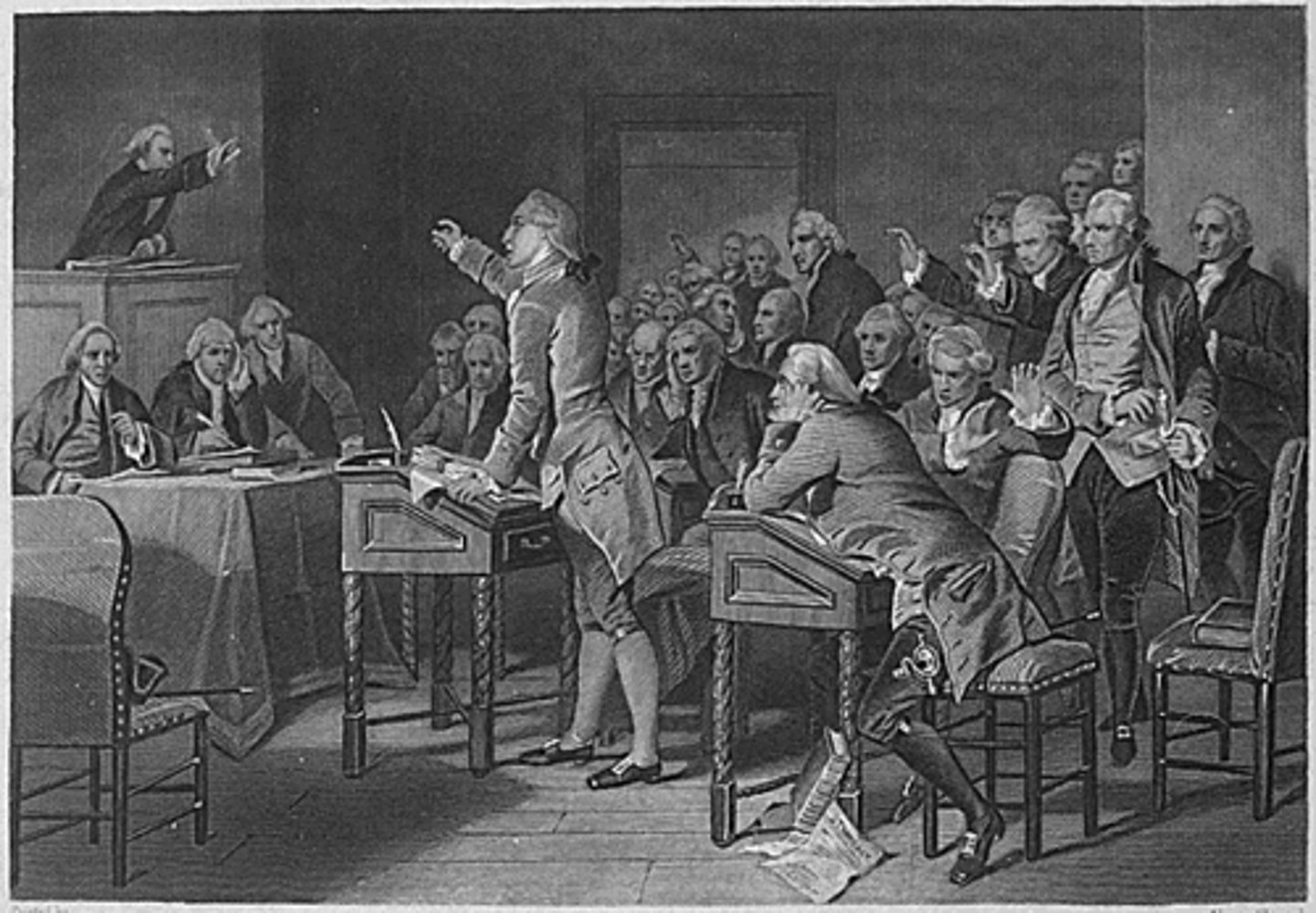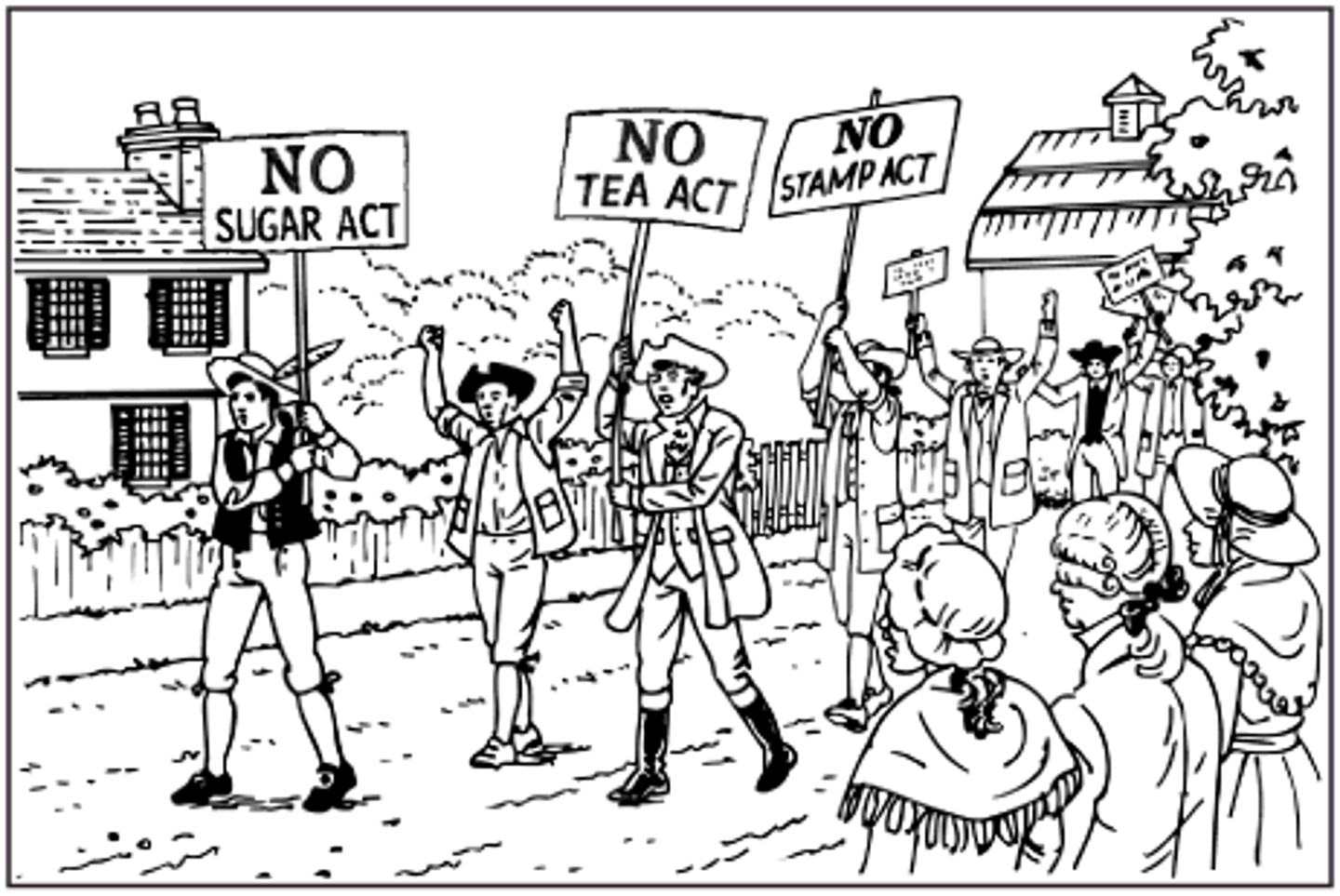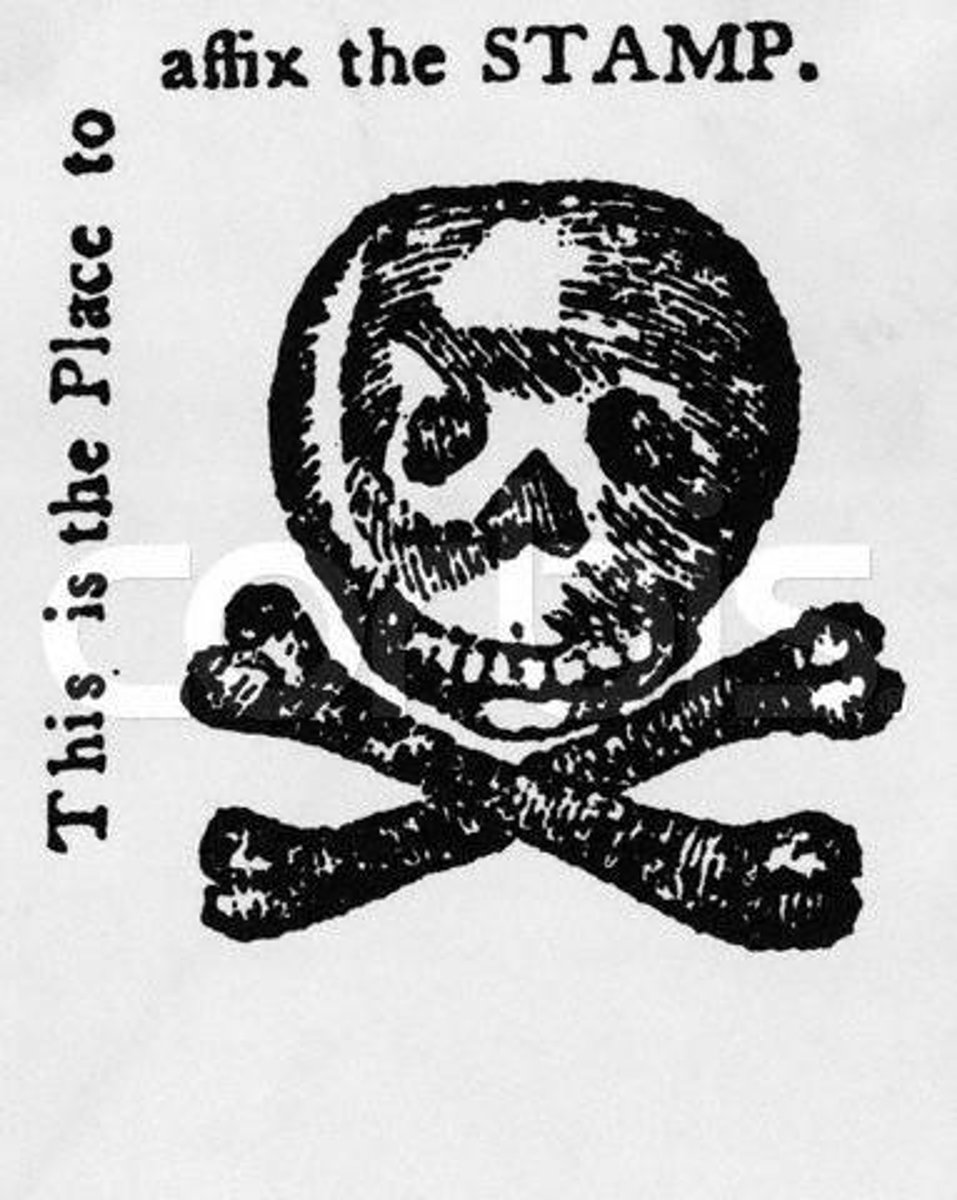APUSH: Period 3 (1754-1800)
1/46
There's no tags or description
Looks like no tags are added yet.
Name | Mastery | Learn | Test | Matching | Spaced |
|---|
No study sessions yet.
47 Terms
French and Indian War
Year: 1754-1763
Summary: Britain defeated France and gained control of French territories in North America but was left with a large debt.
Significance: Led Britain to increase control and taxes on the colonies to pay for debt, ending salutary neglect and fueling colonial resistance.
Albany Congress
Albany Congress
Year: 1754
Summary: Meeting of 7 colonies to discuss defense against the French and form alliances with Native tribes.
Significance: First attempt at colonial unity; Benjamin Franklin's Albany Plan of Union set a precedent for future cooperation during the Revolution.

Imperial Efforts to Raise Revenue and Consolidate Control
Year: 1763-1775
Summary: Britain imposed taxes (Stamp Act (1765), Sugar Act(1764) and tightened trade regulations to pay war debt and assert authority.
Significance: Sparked colonial anger, boycotts, and growing calls for independence. An end to salutory neglect
Colonial Resistance
Year: 1765-1775
Summary: Colonists protested taxes with petitions, boycotts.
Significance: Unified colonies against Britain and set the stage for revolution.
Stamp Act Congress (1765)
What: Delegates from 9 colonies met to protest the Stamp Act.
How it resisted: Declared that only colonial assemblies could tax the colonists.
Significance: First unified colonial response to British policy.

Sons of Liberty (1765+)
Year: Founded in 1765
Summary: A secret organization of American colonists formed to oppose British taxation and policies, especially the Stamp Act.
Significance: Used protests, intimidation, and sometimes violence to resist British authority; played a key role in organizing events like the Boston Tea Party and building support for independence.
Sugar Act
Year: 1764
Summary: Lowered the tax on molasses but strengthened enforcement against smuggling and expanded vice-admiralty courts.
Significance: First revenue-raising act passed by Parliament specifically to raise money from the colonies; angered merchants and set the stage for resistance.

Stamp Act
Year: 1765
Summary: A British law that required colonists to pay a tax on all printed materials, including newspapers, legal documents, and playing cards.
Significance: First direct tax imposed on the colonies; sparked widespread protest and helped unify colonists in opposition, leading to the formation of groups like the Sons of Liberty and the Stamp Act Congress.

Townshend Acts
Year: 1767
Summary: Imposed indirect taxes on imported goods like glass, paint, paper, and tea.
Significance: Reignited protests and boycotts; led to heightened tensions and British troop presence in Boston.
Boston Massacre (1770)
What: British soldiers fired on protesting colonists, killing five.
How it resisted: Used as propaganda by revolutionaries to inflame anti-British sentiment.
Significance: Increased tensions and unified colonial outrage.
Tea Act
Year: 1773
Summary: Allowed the British East India Company to sell tea directly to the colonies at a reduced price, undercutting colonial merchants.
Significance: Seen as a trick to accept British taxation; sparked the Boston Tea Party.
Boston Tea Party
What: Colonists disguised as Mohawk Indians dumped British tea into Boston Harbor.
How it resisted: Protested the Tea Act and taxation without representation.
Significance: Provoked harsh British retaliation through the Coercive (Intolerable) Acts.
Intolerable Acts (Coercive Acts)
Year: 1774
Summary: A series of punitive laws passed after the Boston Tea Party, including the Boston Port Act and the Quartering Act.
Significance: Meant to punish Massachusetts but united the colonies in opposition; led to the First Continental Congress.
Natural Rights, American Enlightenment, John Locke
Year: 1700s
Summary: Enlightenment thinkers like Locke argued government should protect life, liberty, and property.
Significance: These ideas shaped the Declaration of Independence and colonial views on liberty and government.
Patriot Movement
Year: 1770s
Summary: A growing group of colonists who supported independence from Britain.
Significance: Led the fight for revolution and built support through pamphlets, protests, and militias.
The Loyalist
Year: 1770s-1780s
Summary: Loyalists remained loyal to Britain and opposed the Patriots, fearing instability and economic loss.
Significance: Created internal conflict during the Revolution and led to the persecution or exile of many Loyalists.
Ben Franklin
Year: 1706-1790
Summary: Enlightenment thinker, diplomat, inventor, and co-author of the Declaration of Independence.
Significance: Helped negotiate French support during the war and was key in uniting the colonies.Year: 1706-1790
Thomas Paine's Common Sense
Year: 1776
Summary: Pamphlet arguing for independence from Britain using plain, persuasive language.
Significance: Shifted public opinion toward revolution and influenced the Declaration of Independence
Declaration of Independence
Year: 1776
Summary: Document declaring the colonies free from Britain, authored by Thomas Jefferson, Benjamin Franklin, John Adams and approved by Congress.
Significance: Justified rebellion based on Enlightenment principles and launched the Revolutionary War officially.
Revolutionary War
Year: 1775-1783
Summary: War between Britain and the colonies, beginning with Lexington & Concord (1775), turning point at Saratoga (1777), and ending at Yorktown (1781).
Significance: Lexington & Concord started the war, Saratoga gained French support; Yorktown led to British surrender and U.S. independence.
George Washington
Year: 1775-1797
Summary: Commander of the Continental Army and first U.S. president.
Significance: His leadership helped win the war and set precedents for the presidency.
Republican Motherhood
Year: Late 1700s
Summary: Belief that women should raise virtuous citizens in the new republic.
Significance: Expanded women's roles in education and civic life, though not legal rights
Role of Women in the Revolutionary War
Year: 1775-1783
Summary: Women supported the war by managing farms, serving as nurses, spies, and fundraising, and some even disguised themselves to fight.
Significance: Expanded women's public roles and helped inspire the idea of Republican Motherhood, though legal rights remained limited.
Abigail Adams
Year: 1744-1818 (with key influence during the Revolutionary era and early republic)
Summary: Wife of John Adams who advocated for women's rights and famously urged him to "remember the ladies" while drafting new laws.
Significance: Early voice for women's political inclusion; her
Role of African Americans in the Revolutionary War
Year: 1775-1783
Summary: Enslaved and free Black men fought for both the British (promised freedom) and the Patriots.
Significance: Thousands gained freedom, especially through British service, but slavery continued; revealed contradictions between liberty and enslavement.
Role of Native Americans in the Revolutionary War
Year: 1775-1783
Summary: Most Native tribes sided with the British to protect their lands from American settlers.
Significance: After the war, Natives lost British support and land, facing more U.S. expansion and broken treaties.
Lord Dunmore's Proclamation
Year: 1775
Summary: Offered freedom to enslaved people who joined the British Army.
Significance: Motivated some African Americans to fight for Britain and alarmed southern colonists.
Articles of Confederation
Year: 1781-1789
Summary: America's first national government, which gave most power to the states and had a weak central authority.
Significance: Lacked power to tax or regulate trade; its weaknesses led to calls for a stronger federal government and the Constitutional Convention.
U.S. Constitution
Year: 1787 (ratified 1788)
Summary: Replaced the Articles by creating a stronger federal government with three branches and a system of checks and balances.
Significance: Established the framework of U.S. government still used today and balanced power between the national and state governments.
Northwest Ordinance of 1787
Year: 1787
Summary: Law organizing the Northwest Territory and establishing a process for admitting new states.
Significance: Banned slavery in new territories and set a model for orderly expansion.
Shays' Rebellion
Year: 1786-1787
Summary: Massachusetts farmers rebelled against debt and high taxes under the Articles of Confederation.
Significance: Highlighted the weaknesses of the Articles and led to calls for a stronger federal government.
Regional Attitudes Toward Slavery
Year: Late 1700s
Summary: Northern states began gradual emancipation; southern states expanded slavery with new lands.
Significance: Set up sectional tensions that would persist into the 1800s.
Treaty of Greenville
Year: 1795
Summary: After Native defeat at the Battle of Fallen Timbers, tribes ceded land in the Ohio Valley.
Significance: Weakened Native resistance and opened more territory to white settlers.
Growth of Frontier Cultures
Year: 1760s-1790s
Summary: Settlers pushed westward, creating new communities with distinct customs and self-reliance.
Significance: Caused frequent conflict with Natives and challenged federal authority (e.g., Whiskey Rebellion).
Constitutional Compromises
Year: 1787
Summary:
Great Compromise based on the Virginia Plan (senate) and the New Jersey Plan (House of reps) (bicameral Congress), 3/5 Compromise (counting enslaved people), and Electoral College.
Significance: Balanced competing interests and allowed Constitution to be ratified, but embedded inequality.
Federalists
Year: 1787-1790 (Constitutional Ratification Debates)
Summary: Supported ratifying the U.S. Constitution and favored a strong central government.
Significance: Helped shape the new federal system; wrote the Federalist Papers to persuade ratification.
Prominent Members: Alexander Hamilton, James Madison, John Jay, George Washington
Anti-Federalists
Year: 1787-1790
Summary: Opposed the Constitution, fearing centralized power and loss of individual rights.
Significance: Their pressure led to the addition of the Bill of Rights.
Prominent Members: Patrick Henry, George Mason, Thomas Jefferson, Samuel Adams
The Federalist Papers
Year: 1787-1788
Summary: Essays by Hamilton, Madison, and Jay defending the Constitution.
Significance: Influenced ratification debates and helped shape American political thought.
Federalist No. 10; Factions and Democracy; A large republic can best control factions and protect minority rights.
Federalist No. 51: Checks and balances; Checks and balances and separation of powers will prevent any one branch from becoming too powerful.
Federalist No. 78: Judicial Branch; The judicial branch must be independent and has the power of judicial review to protect the Constitution.
Bill of Rights
Year: 1791
Summary: The first 10 amendments to the U.S. Constitution, guaranteeing individual freedoms like speech, religion, and due process.
Significance: Addressed Anti-Federalist concerns about too much federal power and protected civil liberties from government abuse.
John Adams Presidency
Year: 1797-1801
Summary: 2nd president; Federalist who faced domestic conflict and foreign tensions.
Significance: His presidency included the XYZ Affair and the unpopular Alien & Sedition Acts.
Formation of Political Parties / 2 Party System
Year: 1790s
Summary: Federalists favored strong government and commerce; Democratic-Republicans wanted states' rights and an agrarian society.
Significance: Created America's first party system and deepened political divisions.
Hamilton's Financial Plan
Year: 1790-1791
Summary: Included assumption of state debts, a national bank (BUS), and tariffs.
Significance: Strengthened federal power and credit but sparked controversy with Jeffersonians.
Jay's Treaty & Pinckney's Treaty
Year: 1794 (Jay's), 1795 (Pinckney's)
Summary: Jay's Treaty eased tensions with Britain but angered France; Pinckney's Treaty opened Mississippi River trade with Spain.
Significance: Helped avoid war and secured western expansion, but deepened political divides.
Washington's Farewell Address
Year: 1796
Summary: Warned against political parties, sectionalism, and foreign alliances.
Significance: Became a guiding principle for U.S. foreign policy and unity rhetoric.
XYZ Affair & Quasi-War
Year: 1797-1800
Summary: French officials demanded bribes from U.S. diplomats; led to undeclared naval conflict.
Significance: Increased tensions with France and strengthened Federalist support for national defense.
Alien & Sedition Acts
Year: 1798
Summary: Under John Adams, allowed the president to deport non-citizens and prohibited speaking poorly of the U.S. government.
Significance: Criticized as unconstitutional; led to backlash and Jeffersonian opposition.
Virginia & Kentucky Resolutions
Year: 1798-1799
Summary: Jefferson and Madison argued that states could nullify unconstitutional federal laws-- a response to the Alien and Sedition Acts.
Significance: Raised the issue of states' rights and set a precedent for future sectional conflict.